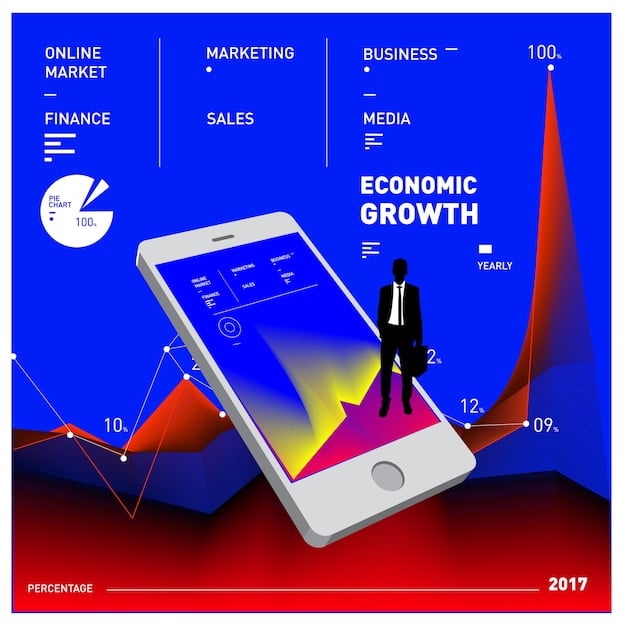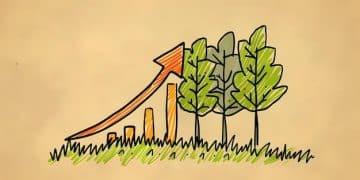Facebook Ad Costs: 3 Ways to Fight 2025 Inflation

Facing rising Facebook ad costs in 2025? Implement strategies like diversifying ad formats, refining audience targeting, and leveraging automation tools to combat inflation and optimize your campaign ROI.
Are you noticing your Facebook ad costs rising? 3 Strategies to Combat Inflation in Your 2025 Campaigns need implementation. As we approach 2025, it’s crucial to prepare for the evolving digital advertising landscape and implement effective strategies to mitigate the impact of inflation on your Facebook ad campaigns.
Understanding the Facebook Ads Cost Landscape in 2025
Understanding the dynamics influencing Facebook ad costs is the first step toward combating inflation. Several factors contribute to these fluctuations, many of which will intensify as we approach 2025.
The interplay of these elements requires advertisers to stay informed and adapt to changes in real-time.
Increased Competition
As more businesses recognize the power of Facebook advertising, competition for ad space intensifies, driving up costs.
This heightened competition means you’re bidding against a larger pool of advertisers for the same audience.
Algorithm Updates
Facebook’s algorithm is constantly evolving, impacting ad delivery and costs. Understanding these changes is crucial for effective campaign management.
Staying ahead of these algorithm updates requires continuous monitoring and adaptation.
- Keep up with Facebook’s official announcements: Regularly check the Facebook Business Help Center and official blog for algorithm updates and best practices.
- Monitor your campaign performance closely: Track key metrics like cost-per-click (CPC), cost-per-impression (CPM), and conversion rates to identify any performance dips after an algorithm update.
- Adapt your bidding strategies: Be prepared to adjust your bidding strategies based on the latest algorithm changes. If you notice that your costs are increasing, try lowering your bids or experimenting with different optimization goals.

In conclusion, understanding the evolving Facebook Ads Cost Landscape in 2025 is crucial for advertisers looking to optimize their campaigns and combat inflation effectively.
Strategy 1: Diversify Your Ad Formats
Diversifying your ad formats beyond traditional image and video ads can significantly reduce costs. Exploring alternative ad formats can create more engaging experiences and potentially lower your overall ad spend.
This diversification strategy helps you reach audiences in innovative ways while maximizing your budget.
Carousel Ads
Showcase multiple products or highlight different features of a single product with engaging carousel ads.
Carousel ads allow users to swipe through a series of images or videos, providing more information and increasing engagement.
Collection Ads
Combine visual elements with a seamless shopping experience with collection ads. These ads are ideal for e-commerce businesses looking to drive sales directly from Facebook.
Collection ads feature a main image or video accompanied by a grid of product images, allowing users to browse and purchase products within the Facebook app.
Instant Experience Ads
Create immersive, full-screen experiences with Instant Experience ads (formerly Canvas ads). These ads load instantly and provide a seamless, interactive experience for users.
Instant Experience ads allow you to tell your brand story in a visually appealing and engaging way.
- Tell a compelling story: Use a combination of images, videos, and text to create a cohesive narrative that captivates your audience.
- Optimize for mobile: Ensure your Instant Experience ads are fully optimized for mobile devices, as most users will be viewing them on their smartphones.
- Incorporate interactive elements: Add interactive elements like swipeable carousels, tilt-to-pan images, and tappable buttons to keep users engaged.
In summary, diversifying ad formats can be a powerful strategy to combat rising Facebook ad costs in 2025.
Strategy 2: Refine Your Audience Targeting
Refining your audience targeting ensures your ads reach the most relevant users, reducing wasted ad spend and increasing conversion rates. Effective audience targeting hinges on a deep understanding of your customer base and their online behavior.
This strategy allows you to optimize your ad campaigns for maximum ROI.

Leverage Custom Audiences
Upload your customer data to create Custom Audiences and re-engage with existing customers on Facebook. This strategy allows you to target users who have already shown interest in your brand.
Custom Audiences can be created from a variety of sources, including customer lists, website traffic, and app activity.
Utilize Lookalike Audiences
Expand your reach by creating Lookalike Audiences based on your existing customer base. Facebook will identify users who share similar characteristics to your best customers.
Lookalike Audiences can be a powerful way to find new customers who are likely to be interested in your products or services.
Detailed Targeting Options
Explore Facebook’s detailed targeting options to reach users based on demographics, interests, behaviors, and more. This precise targeting can significantly improve the relevance of your ads.
Detailed targeting options allow you to narrow your audience based on a wide range of criteria, ensuring that your ads are seen by the right people.
- Test different targeting options: Experiment with different combinations of demographics, interests, and behaviors to identify the most effective targeting parameters for your ads.
- Monitor your audience overlap: Use Facebook’s Audience Overlap tool to identify potential overlap between your audiences. If you find that your audiences are overlapping, consider excluding one from the other to avoid showing the same ads to the same users.
- Review your targeting options regularly: As your business and customer base evolve, your targeting options may need to be adjusted to reflect these changes.
In conclusion, refining audience targeting is a critical strategy for combating Facebook ad inflation in 2025.
Strategy 3: Leverage Automation Tools
Leveraging automation tools can streamline your ad campaigns, improve efficiency, and reduce costs. These tools automate repetitive tasks, allowing you to focus on strategic decisions and creative optimization.
This automation strategy ensures your campaigns are running optimally while minimizing manual effort.
Automated Bidding
Use automated bidding strategies like cost-per-acquisition (CPA) bidding or value-based bidding to optimize your bids based on your business goals.
Automated bidding allows Facebook to automatically adjust your bids in real-time to maximize your ROI.
Ad Scheduling
Schedule your ads to run during specific times when your target audience is most active. This ensures your ads are seen by the right people at the right time.
Ad scheduling can be particularly effective for businesses targeting audiences in different time zones.
Dynamic Creative Optimization
Utilize dynamic creative optimization to test different ad variations and identify the most effective combinations of headlines, images, and call-to-action buttons.
Dynamic creative optimization allows Facebook to automatically show the best-performing ad variations to each user, improving your overall campaign performance.
- Test different ad variations: Experiment with different ad variations to identify the most effective combinations of headlines, images, and call-to-action buttons.
- Monitor your campaign performance closely: Track key metrics like click-through rates (CTR) and conversion rates to identify which ad variations are performing best.
- Adapt your creative strategy: Based on your campaign performance, adjust your creative strategy to focus on the most effective ad variations.
In summary, leveraging automation tools is an essential strategy for combating rising Facebook ad costs in 2025.
The Role of A/B Testing in Reducing Ad Spend
A/B testing plays a pivotal role in reducing ad spend by identifying the most effective ad creatives and targeting strategies. Running A/B tests allows you to make data-driven decisions, optimizing your campaigns for maximum ROI.
This rigorous testing ensures your budget is allocated to what truly works.
Testing Ad Creatives
Experiment with different ad creatives, including images, videos, and ad copy, to identify the most engaging and persuasive elements. This can dramatically improve your click-through rates and conversion rates.
Testing different ad creatives helps you understand what resonates best with your audience.
Testing Audience Segments
Divide your audience into different segments and test different ad variations to identify which segments respond best to specific messaging. This allows you to tailor your ads for maximum impact.
Testing audience segments ensures your ads are relevant to each group, improving engagement and conversion rates.
Testing Placement Options
Test different placement options, such as Facebook News Feed, Instagram Feed, and Audience Network, to identify the most effective placements for your ads. This ensures your ads are seen where your audience is most active.
Testing placement options helps you allocate your budget to the placements that deliver the best results.
- Isolate variables: When conducting A/B tests, make sure to isolate the variables you’re testing. For example, if you’re testing different headlines, keep the image and ad copy the same.
- Run tests for a sufficient duration: Make sure to run your A/B tests for a sufficient duration to gather enough data to draw meaningful conclusions.
- Analyze your results: Carefully analyze your A/B testing results to identify the winning variations. Use these insights to optimize your ad campaigns for maximum ROI.
In conclusion, A/B testing is an indispensable tool for reducing ad spend and improving the effectiveness of your Facebook ad campaigns in 2025.
Monitoring and Analyzing Ad Performance
Monitoring and analyzing ad performance is crucial for identifying areas for improvement and optimizing your campaigns for maximum ROI. Regularly tracking key metrics allows you to make informed decisions and adjust your strategies to combat rising ad costs.
This data-driven approach ensures your campaigns are always performing at their best.
Key Metrics to Track
Keep a close eye on key metrics like cost-per-click (CPC), cost-per-impression (CPM), click-through rate (CTR), conversion rate, and return on ad spend (ROAS). These metrics provide valuable insights into your campaign performance.
Tracking these metrics helps you understand how your ads are performing at each stage of the funnel.
Using Facebook Analytics
Utilize Facebook Analytics to gain a deeper understanding of your audience and their behavior. This tool provides valuable insights into demographics, interests, and purchase patterns.
Using Facebook Analytics allows you to refine your targeting strategies and create more relevant ads.
Generating Reports
Generate regular reports to track your campaign performance over time. This allows you to identify trends and make adjustments to your strategies as needed.
Generating reports helps you stay on top of your campaign performance and identify areas for improvement.
- Set clear goals: Before you start monitoring and analyzing your ad performance, set clear goals for your campaigns. What are you trying to achieve? What metrics will you use to measure success?
- Use a spreadsheet or dashboard: Create a spreadsheet or dashboard to track your key metrics over time. This will help you identify trends and make adjustments to your strategies as needed.
- Don’t be afraid to experiment: Experiment with different ad creatives, targeting options, and bidding strategies to see what works best for your business.
In conclusion, monitoring and analyzing ad performance is essential for combating rising Facebook ad costs in 2025.
| Key Point | Brief Description |
|---|---|
| 💡 Ad Diversification | Explore formats like carousel & instant experiences to engage audiences. |
| 🎯 Audience Refinement | Use custom and lookalike audiences for precise targeting. |
| ⚙️ Automation Tools | Implement automated bidding & dynamic creative optimization. |
| 📊 A/B Testing | Test creative & targeting to reduce ad spend. |
What affects Facebook ad costs?
▼
Facebook ad costs are influenced by factors like competition, audience size, ad quality, placement, and seasonality.
▼
Lowering costs involves refining your audience, improving ad relevance, optimizing bids, and experimenting with different ad formats.
▼
Custom audiences let you target ads to people who’ve interacted with your business, like website visitors or email subscribers.
▼
A/B testing compares different ad versions, helping you identify the most effective strategies for better ROI.
▼
Highly relevant ads tend to have lower costs because they appeal more to the target audience, improving engagement.
Conclusion
As Facebook ad costs continue to rise, adopting these strategies is essential for maintaining a cost-effective and successful advertising presence. By diversifying your ad formats, refining your audience targeting, and leveraging automation tools, you can effectively combat inflation and optimize your campaigns for maximum ROI in 2025 and beyond.





